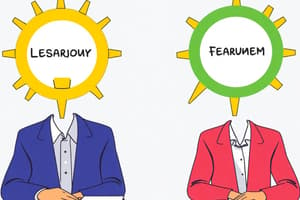Podcast
Questions and Answers
What describes the leader's behavior in the Selling leadership style?
What describes the leader's behavior in the Selling leadership style?
- The leader provides only directive behavior.
- The leader provides minimal support and focuses solely on tasks.
- The leader avoids decision-making and lets followers lead.
- The leader provides both directive and supportive behavior. (correct)
Which stage of follower readiness describes followers who are competent but unwilling?
Which stage of follower readiness describes followers who are competent but unwilling?
- R3: Able but unwilling (correct)
- R2: Unable but willing
- R4: Able and willing
- R1: Unable and unwilling
What type of power is based on a leader's position within the organization?
What type of power is based on a leader's position within the organization?
- Legitimate power (correct)
- Expert power
- Coercive power
- Referent power
Which dimension of trust pertains to a leader's ability to be reliable and exercise good judgment?
Which dimension of trust pertains to a leader's ability to be reliable and exercise good judgment?
What is the key characteristic of Referent power?
What is the key characteristic of Referent power?
What is the primary role of a leader?
What is the primary role of a leader?
Which trait is most associated with high levels of energy and persistence?
Which trait is most associated with high levels of energy and persistence?
Why is self-confidence important for a leader?
Why is self-confidence important for a leader?
What characteristic is essential for leaders when it comes to problem-solving?
What characteristic is essential for leaders when it comes to problem-solving?
Which trait involves a strong commitment to ethical behavior and consistency between word and deed?
Which trait involves a strong commitment to ethical behavior and consistency between word and deed?
What does job-relevant knowledge enable a leader to do?
What does job-relevant knowledge enable a leader to do?
Which trait is most likely to describe individuals who are vibrant and enthusiastic?
Which trait is most likely to describe individuals who are vibrant and enthusiastic?
What factor has research shown to be unreliable in distinguishing leaders from non-leaders?
What factor has research shown to be unreliable in distinguishing leaders from non-leaders?
What trait is positively related to leadership effectiveness due to a strong sense of responsibility for others?
What trait is positively related to leadership effectiveness due to a strong sense of responsibility for others?
Which leadership style focuses on dictating work methods and centralizing decision making?
Which leadership style focuses on dictating work methods and centralizing decision making?
Which trait allows leaders to empathize and understand the unspoken needs of their followers?
Which trait allows leaders to empathize and understand the unspoken needs of their followers?
What does the consideration dimension in leadership behavior emphasize?
What does the consideration dimension in leadership behavior emphasize?
Which behavioral theory suggests that a leader high in both consideration and initiating structure achieves high performance?
Which behavioral theory suggests that a leader high in both consideration and initiating structure achieves high performance?
What is a characteristic of individuals with high conscientiousness in a leadership context?
What is a characteristic of individuals with high conscientiousness in a leadership context?
Which leadership style is associated with granting teams the freedom to make their own decisions?
Which leadership style is associated with granting teams the freedom to make their own decisions?
What did the University of Iowa study conclude about the democratic style of leadership?
What did the University of Iowa study conclude about the democratic style of leadership?
What characteristic is associated with employee-oriented leaders?
What characteristic is associated with employee-oriented leaders?
In the context of Fiedler's Model, what does a low score on the concern for production scale indicate?
In the context of Fiedler's Model, what does a low score on the concern for production scale indicate?
Which of the following is a measure used in Fiedler's model to evaluate leadership style?
Which of the following is a measure used in Fiedler's model to evaluate leadership style?
What aspect does the term 'leader-member relations' describe?
What aspect does the term 'leader-member relations' describe?
In Hersey and Blanchard's situational leadership theory, what does 'readiness' refer to?
In Hersey and Blanchard's situational leadership theory, what does 'readiness' refer to?
What is a defining feature of the 'telling' leadership style in situational leadership theory?
What is a defining feature of the 'telling' leadership style in situational leadership theory?
What do strong position powers in Fiedler's contingencies indicate?
What do strong position powers in Fiedler's contingencies indicate?
Which leadership style aligns with a 9,9 score on the Managerial Grid?
Which leadership style aligns with a 9,9 score on the Managerial Grid?
Flashcards are hidden until you start studying
Study Notes
Leadership Styles
- Selling (high task–high relationship leadership): Leaders provide both direction and support to their team. This style is often appropriate when followers are able but unwilling, as it helps them understand why their contributions are valuable.
- Participating (low task–high relationship leadership): Leaders and followers make decisions together. The leader acts as a facilitator and communicator. This style is best when followers are able and willing, as it fosters a collaborative and positive decision-making environment.
- Delegating (low task–low relationship leadership): Leaders offer little direction or support. This style is best when followers are able and willing, as they are able to take ownership of their work without needing constant guidance.
Follower Readiness Stages
- R1: Followers are unable and unwilling. They lack competence and confidence, requiring a telling leadership style (high task, low relationship) for guidance.
- R2: Followers are unable but willing. They are motivated but lack the skills, requiring a selling leadership style (high task, high relationship) for both instruction and support.
- R3: Followers are able but unwilling. They are competent but lack motivation, requiring a participating leadership style (low task, high relationship) to foster engagement.
- R4: Followers are able and willing. They are both competent and motivated, requiring a delegating leadership style (low task, low relationship) for autonomy.
Leadership Power
- Legitimate power: Stems from a leader's position within an organization. This power comes with the authority granted to the role.
- Coercive power: Based on a leader's ability to punish or control. This power relies on fear and the potential for negative consequences in the workplace.
- Reward power: Derived from a leader's ability to provide positive rewards. This power can be motivational as long as the rewards are seen as desirable by the team.
- Expert power: A leader's influence stems from their expertise, skills or knowledge. This power is earned through credibility and competence.
- Referent power: Based on a leader's desirable resources or personal traits. This type of power stems from personal charisma, strength, or influence that attracts others.
Developing Trust
- Credibility: Reflects followers' perception of a leader's honesty, competence, and ability to inspire.
- Trust: Belief in a leader's integrity, character, and ability.
- Five Dimensions of Trust: Integrity, competence, consistency, loyalty, and openness.
Leadership Traits
- Drive: Leaders are highly motivated and driven; they are ambitious, energetic, and persistent.
- Desire to lead: Leaders have a strong desire to influence and lead others; they actively seek responsibility.
- Honesty and integrity: Leaders establish trust by being truthful and consistent in their words and actions.
- Self-confidence: Leaders are confident in themselves and their abilities, which inspires confidence in their followers.
- Intelligence: Leaders possess the intellectual capacity to gather, analyze, and synthesize information, allowing them to make sound decisions.
- Job-relevant knowledge: Leaders have a deep understanding of their industry, company, and technical matters. This knowledge allows them to make informed decisions.
- Extraversion: Leaders are typically energetic, sociable, and assertive. They are not withdrawn or quiet.
- Proneness to Guilt: Leaders tend to feel a sense of responsibility for others; they are concerned with the potential for negative outcomes.
- Emotional Intelligence: Leaders are empathetic and understanding; they are able to sense others' emotions, listen actively, and read non-verbal cues.
- Conscientiousness: Leaders are disciplined and committed; they follow through on their promises and keep obligations.
Leadership Behaviors
- Behavioral theories of leadership: Aim to identify specific behaviors that distinguish effective leaders from ineffective ones.
- Democratic leadership: Focuses on involving followers, delegating authority, and encouraging participation.
- Autocratic leadership: Emphasizes centralized decision-making, dictating work methods, and limiting follower participation.
- Laissez-faire leadership: Allows group freedom with minimal direction.
- Consideration (Ohio State Studies): Focuses on valuing followers' ideas and emotions.
- Initiating structure (Ohio State Studies): Focuses on structuring work and relationships to achieve organizational goals.
- Employee-oriented leadership (University of Michigan Studies): Prioritizes interpersonal relationships and supports employee needs.
- Production-oriented leadership (University of Michigan Studies): Emphasizes technical tasks and job performance.
- Concern for people (Managerial Grid): Reflects a leader's concern for followers' well-being on a scale of 1 to 9 (low to high).
- Concern for production (Managerial Grid): Reflects a leader's concern for task completion on a scale of 1 to 9 (low to high).
- 9,9 style (Managerial Grid): Characterized by high concern for both people and production.
Fiedler's Contingency Model
- Fiedler contingency model: Focuses on the interaction between a leader's style and the situation.
- Least-preferred coworker (LPC) questionnaire: Measures whether a leader is task-oriented or relationship-oriented.
Fiedler's Situational Contingencies
- Leader–member relations: The level of trust, respect, and confidence followers have in their leader.
- Task structure: The degree to which job assignments are organized and clearly defined.
- Position power: The level of authority and influence a leader has over tasks such as hiring, firing, promotions, etc.
Hersey and Blanchard’s Situational Leadership Theory
- Situational leadership theory (SLT): Emphasizes follower readiness as key to selecting the appropriate leadership approach
- Readiness: The individual's ability and willingness to perform a specific task
SLT Leadership Styles
- Telling (high task–low relationship leadership): Providing specific instructions to followers on tasks, processes, and timelines.
- Selling (high task–high relationship leadership): Providing both instruction and support to followers, explaining the rationale behind decisions.
- Participating (low task–high relationship leadership): Collaborating with followers, allowing for input and shared decision-making.
- Delegating (low task–low relationship leadership): Empowering followers with autonomy and responsibility for tasks.
- R1 (unable and unwilling): Telling style.
- R2 (unable but willing): Selling style.
- R3 (able but unwilling): Participating style.
- R4 (able and willing): Delegating style.
Studying That Suits You
Use AI to generate personalized quizzes and flashcards to suit your learning preferences.




